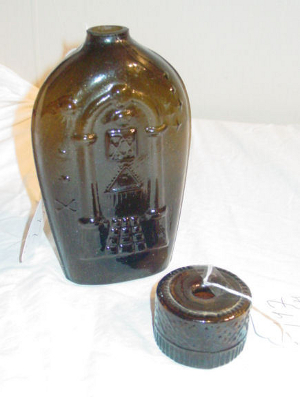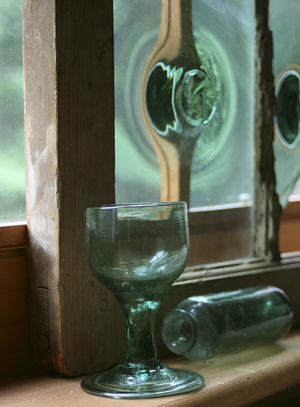
Conditions in 1780 were primitive, but wood for fuel and sand for glassmaking were plentiful at the Temple factory.
“Nowadays, we’re all moaning about all of our basic industries going overseas,” said David Starbuck, an associate professor of anthropology and sociology at Plymouth State University. “This is a made-in-New Hampshire story. These factories made very good glass.”
Area historical societies are paying tribute to the glassworks and four other early factories in New Hampshire that made bottles, flasks and decanters for markets throughout the Northeast. An exhibit is scheduled to open Nov. 13 at the Peterborough Historical Society.
The exhibit will cover 1780 to 1886 – the Revolutionary War era through the Industrial Revolution. More than 200 items will be on display through mid-February from museums, historical societies and private collections, including about a dozen bottles thought to be from the Temple factory. Many items have seldom or never been seen by the public.
The Temple glass factory existed just two years. But almost 200 years later, it became the site of an archaeological dig that yielded thousands of shards of glass, workers’ cabins, a furnace and factory ovens.
It was the first one in the country to make crown window glass that had a distinctive bull’s-eye-type lump in the center, said Starbuck, an archaeologist and the director of the Boston University dig.
Throughout the 19th century, the window glass was widely manufactured at other factories.
Anne Lunt, president of the Historical Society of Temple, said research and coordination efforts for the exhibit began a little over a year ago. The exhibit will include artifacts from the factories – the others were in Keene, Stoddard, Lyndeborough and Suncook – such as canes, rolling pins and miniature top hats.
Lunt said the exhibit and a lecture series will look at the impact of the industry on the economy and on New England history. They will recount the Temple dig and the origins of the factory, started by Robert Hewes of Boston, who owned various businesses, including a slaughterhouse and a tannery.
Starbuck said Hewes started other glassworks in Massachusetts and Connecticut after the Temple factory closed.
“The woods of New Hampshire was a bit much for them, but it was a grand beginning,” he said. “It did inspire other people to start their own factories in other locations that weren’t too far away.”
Michael George, a glass historian and private collector in New Boston who is a curator for the exhibit, said it was difficult to run the factories.
“They were always fighting the elements,” he said. “To keep these furnaces hot enough to melt the glass they had to be burning wood constantly, and sometimes it would take days for the furnace to get hot enough to make the glass. With that kind of heat and fire within a wooden structure, they were also prone to being burnt down, so fire was one of the main causes of closure.”
There were several factories in Keene from 1814 to 1855. They produced glass in shades of green, blue and amber, and some rare pieces in amethyst. They were known for their decanters and flasks, including ones showing Masonic images and patriotic eagles. Keene also developed more sophisticated molds to create intricate designs mimicking English and Irish cuts as glassmakers dealt with European trade embargoes at the time.
Lyndeborough was known for commercial bottles, including Moxie Nerve Food, Pinkham’s Vegetable Compound and Hood’s Sarsaparilla. The Suncook factory produced window glass and tableware, such as pitchers and bowls in a clear aqua.
Most of the glass produced in Stoddard was dark amber and green. One factory specialized in spring water bottles for the spas at Saratoga, N.Y., and mineral springs in Vermont, New Hampshire and Massachusetts.
Chris Salmon, a glassblower in Antrim, not far from the old factories, said he likes the primitive nature of the old bottles. They have influenced his own creations. “I made several bottles that were similar to the Stoddard bottles that were made for Saratoga Spring Water in the early 1800s,” he said. He called them “the Coke bottles of their time.”
___
Online: www.nhglassmakers.com
Copyright 2010 Associated Press. All rights reserved. This material may not be published, broadcast, rewritten, or redistributed.
AP-ES-11-06-10 1234EDT
ADDITIONAL IMAGE OF NOTE


